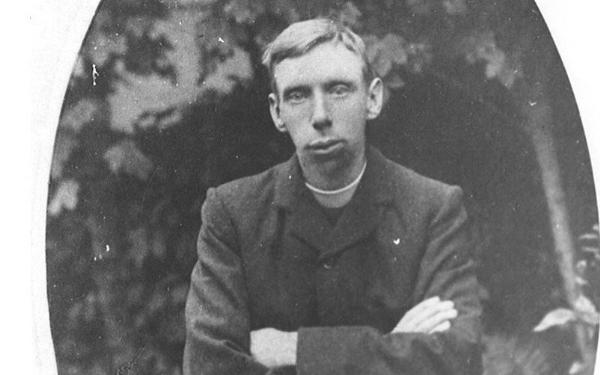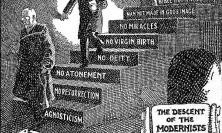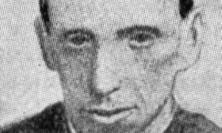
This month sees the 100th anniversary of the death of the controversial Jesuit, George Tyrrell. Oliver Rafferty SJ begins Thinking Faith’s series on Tyrrell’s life and work by introducing us to the Catholic modernist whose views eventually resulted in his expulsion from the Society of Jesus and his excommunication. Who was George Tyrrell?
George Tyrrell was one of the most remarkable Jesuits that the English Province of the Society of Jesus has ever produced. He was a man of great pastoral sensitivity, widely sought after as a retreat giver, preacher, spiritual guide and confessor. He was also possessed of a keen intellect and deep insight into the nature and role of religion in life, amounting to what has been called ‘religious genius’. By the late 19th century he had become, perhaps, the most important Catholic theologian in England.
By the time Tyrrell died in July 1909, at Storrington, West Sussex, he had been expelled from the Jesuits and excommunicated from the Church which, at times, he seemed to love and loathe in equal measure. He was refused Catholic burial, despite the fact that he had made his confession to a priest in good standing and had received the last rites from the Prior of the Norbertine religious community at Storrington. Bishop Peter Amigo of Southwark, in whose diocese Tyrrell died, was under some pressure from the Vatican and was concerned about the fact that Tyrrell had not publicly repudiated his theological views, which were taken by the Holy See to be heretical. Why had Tyrrell’s life, which had seemed to offer such promise, come to an end in such heart-breaking circumstances?
Tyrrell was born in Dublin in 1861, two months after the death of his father. William Tyrrell had been a sub-editor on the Dublin Evening Mail, a newspaper of Tory and Orange sympathy. Following her husband’s death, Mary Tyrrell was forced to work in order to support her three small children (a fourth had died in infancy). The Tyrrells were a typical product of the Anglo-Irish Protestant ascendancy, now reduced to genteel poverty. They were also part of a highly intelligent clan, and as a young child George lived in the shadow of his brilliant older brother and cousins. He himself was, by contrast, a rather poor student, despite his conspicuous intelligence, and in fact he performed rather poorly in the Hebrew entrance exams for Trinity College, Dublin.
The religious atmosphere of the Tyrrell household was, on the whole, one of neglectful benevolence, although Tyrrell’s older brother was an ardent sceptic. As a teenager, however, Tyrrell longed for a more devout spiritual life, and this brought him initially to All Saints’ Church, Grangegorman, an unusual high-church outpost within the notoriously evangelical Anglican Church of Ireland. He also came under the influence of Robert Dolling, who would in later life make his mark in England as a social reformer and a high church Anglican priest. Invited by Dolling to England in April 1879, Tyrrell’s spiritual quest brought him to the Jesuit Church at Farm Street in Mayfair, and it was there that he was received into the church on 18 May that year. Almost immediately he decided he wanted to be a Jesuit and, although encouraged in this by the priest who received him and by the novice master, the Jesuit Provincial Superior decided that Tyrrell should wait for a year. In the meantime he was sent to teach at Jesuit schools first in Cyprus and then in Malta. It was agreed that if, at the end of the year, he no longer wanted to be a Jesuit then Tyrrell would be paid £80; otherwise he would enter the novitiate at Manresa House, Roehampton.
Tyrrell would in later years claim that the experiences of Jesuit life in Malta sowed the seeds of his future scepticism. Nevertheless he joined the Jesuits, as arranged, on 8 September 1880. His initial years, although difficult, seem to have been filled with sufficient religious consolation as to enable him to pass through the various stages of Jesuit training quite successfully. Furthermore, it was as a young scholastic (as student members of the Society of Jesus were called) that he began to develop an abiding interest in the philosophy and theology of St Thomas Aquinas. He came under the influence of certain tendencies in the Jesuit order that thought St Thomas ought to be read and studied in his own terms rather than through the interpretative commentaries of the outstanding sixteenth century Jesuit, Francisco Suarez. Indeed this ‘Thomas as his own interpreter’ school had been given authoritative approval by Pope Leo XIII in his 1879 encyclical Aeterni Patris. Many in the order, however, resented the Pope’s intervention and continued to teach Aquinas through ‘Suarezian lenses’. Tyrrell, always one for a good scrap, threw himself wholeheartedly into the ‘Thomas as he is’ school.
At the end of his theological studies, and following ordination, tertianship (a year of spiritual reflection after the long studies for ordination) and a brief period of pastoral work in Lancashire, Tyrrell was sent to teach philosophy at the Jesuit seminary, St Mary’s Hall, Stonyhurst. Given his views, however, he quickly came into conflict with the more conservative philosophers on the seminary staff. The freshness of his approach, his clarity of exposition and the tenacity with which he held his views soon gave rise to something approaching a cult-like status among the more intelligent Jesuit seminarians. His general behaviour was, however, simply too disruptive and it was decided to remove him from teaching in 1896. He had already come to the attention of the Father General of the Jesuit Order in Rome.
From September 1896 Tyrrell was assigned as a staff writer on the Jesuit journal, The Month, and he lived mostly at Farm Street. The next four years were a period of great creativity for him as a theological writer and it was at this time that he gained his reputation as a ‘guide of souls’. He also began to develop an approach to religion that was quite different from the position he had championed at St Mary’s Hall. In particular, he was concerned that the conventional theological and spiritual doctrine as taught and practised by that late stage of the 19th century was not meeting the intellectual and spiritual needs of ‘modern’ man.
For a time, Tyrrell was enamoured with the new insights gained from a more scientific method of examining of Christianity, as seen in the new critical approach to the theological sciences. To some degree, he began to believe that these new insights undermined some of the Church's traditional beliefs, such as in the inerrancy of scripture. He became convinced that the Church placed too much emphasis on the ‘external’ manifestation of religion, with its system of norms and obligations, at the expense of what really counted: the inner workings of God in the individual soul.
This was a time of growing unease in the Church as a whole, and a number of Catholic theologians and writers began to postulate a new relationship between the Church and the world, whereby Catholicism would be ‘more open’ to modern society and current intellectual speculation. Although not in fact forming a distinct group and not necessarily having direct contact with one another, these individuals became known collectively as ‘modernists’. Tyrrell in particular argued that the Church’s response to the religious problems of the modern age could not be simply to reiterate Christian truths which had been formulated and systematised in the thirteenth century. Like Newman, he was also concerned with the organic development of faith over time, influenced as this process was by the cultural environment in which the faith was expressed. He liked to point out that even Aquinas was treated as a ‘modernist’ in his own day. For Tyrrell the problems of scepticism, disbelief and the spiritual quest for the divine had to be answered in a way that was meaningful in the here and now.
Tyrrell’s views at this time were expressed not only in essays, reviews and letters, but also in four books, the most important of which were Hard Sayings (1898) and External Religion: its use and abuse (1899). But it was an essay on the unlikely subject of hell, published in the Weekly Register in December 1899, which caused the greatest outcry against Tyrrell to that date. In the essay, ‘A Perverted Devotion’ Tyrrell lampooned much of the Catholic attitude to hell. He believed that in some respects the idea of eternal punishment for sins sat uneasily with the idea of a God who took the suffering and sins of humanity upon himself so that we might be saved. He thought that in some respects the Church’s teaching on hell was both cruel and unjust. But perhaps the boldest statement of all was his assertion that a certain ‘temperate agnosticism’ about the prescriptions of Catholicism in matters such as hell was an essential prerequisite for intelligent faith.
For these views the General Superior of the Jesuits, Fr Luís Martín, demanded that Tyrrell should no longer write for any publication save The Month, and then only after rigorous censorship had been applied to his work. Although all Tyrrell’s writings had in fact been censored, Martín complained that the censors had been too lax. Fr Martín’s intervention in the Tyrrell case was not simply a routine act of religious government. For some time Martín had been deeply suspicious of the English Province of the Jesuits, whose members he felt were not sufficiently robust in defending Catholic values and views of history against the prevailing Protestant ethos of English secular society. He also thought that the English Jesuits were on the whole too undisciplined and that they abused alcohol. The Tyrrell case was an epitome of his worst fears about the Jesuits in England.
Meanwhile, at his own request, Tyrrell was rusticated to parochial ministry in Richmond, Yorkshire, where he was to live for the next five years. This was a period of growing productivity, but also one of growing disaffection with the Jesuits and the Church. He was especially disillusioned with the pontificate of Pope Pius X, whom he recognised as a good man but said that goodness can be narrow, irritating and fierce. Since he was forbidden to publish anything that had not been censored, Tyrrell began to publish anonymously and pseudonymously. Although in many respects his thinking remained sharp and illuminative, he could become wildly abusive and sarcastic. He also began to suffer from the early stages of the illness that would eventual take him to an early grave: Bright’s disease.
The break with the Jesuits finally came in February 1906 when, following the publication of some of his views in an Italian newspaper, for which Tyrrell was not responsible, he was expelled from the Society by the Father General. He was now in effect a suspended priest, unable to celebrate the Mass for which he longed. And although he could have received communion as an ordinary participant at Mass, for several months and for various reasons he deprived himself of this expedient.
With the condemnation of modernism, first in the sixty-five propositions of the decree Lamentabili in July 1907 and then in the encyclical Pascendi in September 1907, Tyrrell's fate was sealed. He was deprived of the sacraments – described by Bishop Amigo as ‘a minor excommunication’ – for his robust criticism of Pascendi which appeared in The Times on 30 September and 1 October 1907. In his rebuttal of Pius X’s encyclical, Tyrrell alleged that the Church’s thinking was based on a theory of science and on a psychology that seemed as strange as astrology to the modern mind. Tyrrell accused Pascendi of equating Catholic doctrine with scholastic theology and of having a completely naïve view of the idea of doctrinal development. He furthermore asserted that when the encyclical tried to show the ‘modernist’ that he was not a Catholic, all it succeeded in doing was showing that he was not a scholastic.
When he died two years later, since he could not be buried according to Catholic rites, some of his friends including Frederick Von Hügel, Maude Petre and his cousin Sir William (later Lord) Tyrrell, arranged for him to be buried in the Anglican churchyard at Storrington, ironically in a spot almost exactly halfway between the Catholic and Anglican churches. The French priest, and former Jesuit, Abbe Henri Bremond read some prayers and gave a funeral address. Thus was laid to rest one of the most intriguing thinkers the Church in this country has produced in modern times. The issues he dealt with are still germane to our own age and time, and will be for every age. Tyrrell was ultimately concerned with the question of how to make Christianity meaningful in a scientific age, of how to recast the formulation of Christian belief in a manner that made sense to the ‘modern’ world. The idea of adaptability has, in another context, been well summarised by Newman in a maxim that could serve as a motto for life as a whole: ‘to live is to change, and to be perfect is to have changed often’.
Oliver P. Rafferty SJ teaches church history at Heythrop College, London. His most recent book is The Catholic Church and the Protestant State: Nineteenth-Century Irish Realities (Dublin, 2008). He is editor of the forthcoming George Tyrrell and Catholic Modernism: A Reassessment (Dublin, 2010).
Thinking Faith’s series on George Tyrrell SJ:
![]() George Tyrrell and John Sullivan: Sinner and Saint? – Michael Hurley SJ
George Tyrrell and John Sullivan: Sinner and Saint? – Michael Hurley SJ![]() Modernism: The Philosophical Foundations – Anthony Carroll SJ
Modernism: The Philosophical Foundations – Anthony Carroll SJ![]() Faith, Reason and the Modernists – Joe Egerton
Faith, Reason and the Modernists – Joe Egerton





